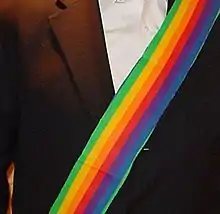Rainbow Sash Movement
The Rainbow Sash Movement is an organisation of gay, lesbian, bisexual, and transgender Catholics, with their families and friends, who are publicly calling the Catholic Church to a 'conversion of heart around issues of human sexuality'.[1] The Movement was established in Melbourne in 1998, in response to the refusal in 1997 by London's Cardinal Basil Hume, and Melbourne's Archbishop George Pell and Cardinal John O'Connor, to provide communion to two openly gay Catholic men, one a priest. On Pentecost Sunday 31 May 1998 a group of 70 people attended Mass in St Patrick's Cathedral, Melbourne, wearing a Rainbow Sash.[2] Central to this process was the development of the movement's Core Statement by the convenors of the group, who at this time were Michael B. Kelly, Geoffrey Baird, David Barker, Ivan Tchernegovski, and David McKenna. The Australian Rainbow Sash Movement became an incorporated group, and supported a number of events over the following years, before winding up in 2003.

The Rainbow Sash Movement was taken up in US in 2000, with Melbourne-based Michael B. Kelly as the group's international spokesperson.
The Rainbow Sash itself is a strip of a rainbow colored fabric which is worn over the left shoulder and is put on at the beginning of the Liturgy. The members go up to receive Eucharist.[3] If denied, they go back to pews and remain standing,[4] but if the Eucharist is received then they go back to the pew and kneel in the traditional way.[5]
See also
- Homosexuality and Roman Catholicism
- LGBT-affirming Christian denominations
References
- The Rainbow Sash Movement - Our history
- The Rainbow Sash Movement - Our history
- "Rainbow Sash Movement at London's Westminister Cathedral" Archived May 21, 2010, at the Wayback Machine
- Rainbow Sash Movement History in the United States, Australia, and England Archived 2012-03-28 at the Wayback Machine
- "Group tries to block gays at communion in St. Paul Cathedral", by Chao Xiong, Star Tribune, May 31, 2004 Archived August 20, 2008, at the Wayback Machine